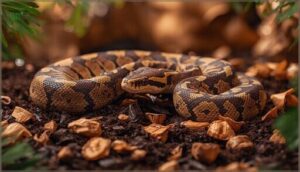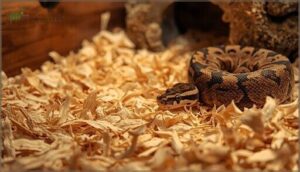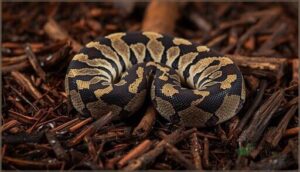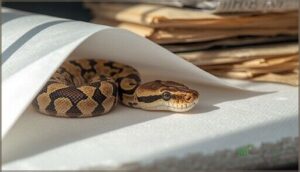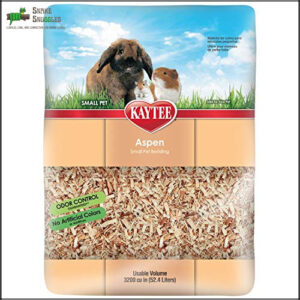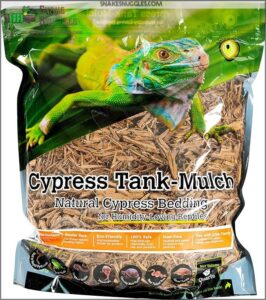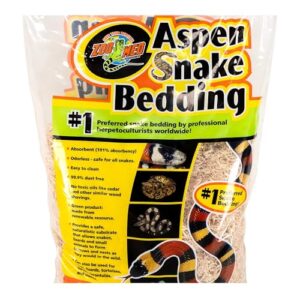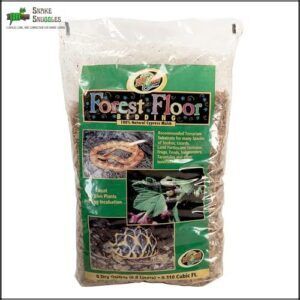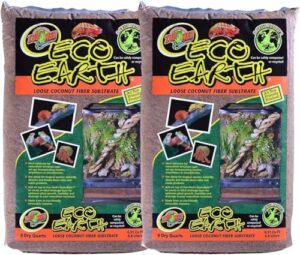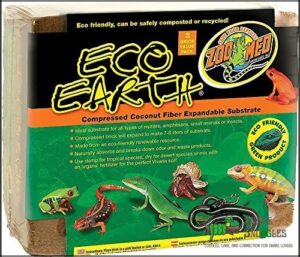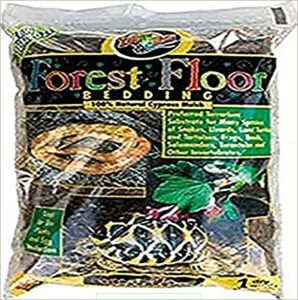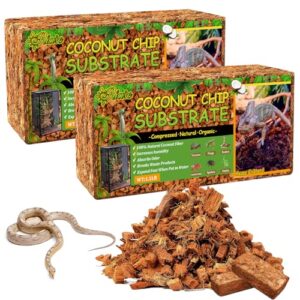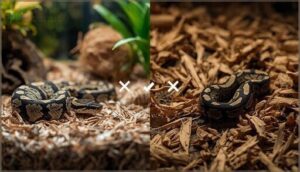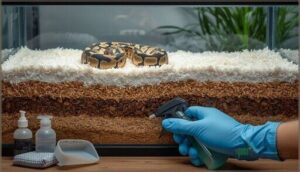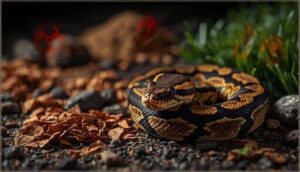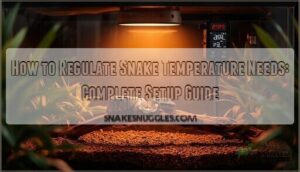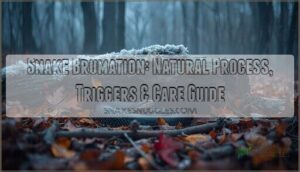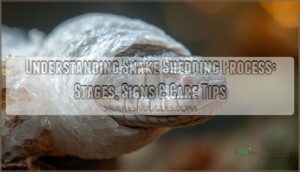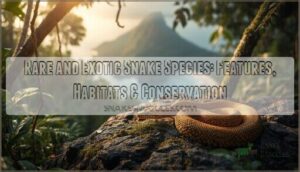This site is supported by our readers. We may earn a commission, at no cost to you, if you purchase through links.
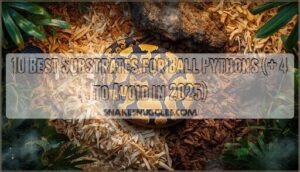
Your ball python’s substrate isn’t just bedding—it’s the foundation of their respiratory health, hydration, and overall wellbeing. Choose wrong, and you’ll face a cascade of problems: inadequate humidity leading to stuck sheds, dusty particles triggering respiratory infections, or worse, toxic oils from aromatic woods causing neurological damage.
The right substrate maintains that critical 50-70% humidity range, absorbs waste efficiently, and facilitates natural burrowing behaviors without posing ingestion risks.
But with dozens of products claiming to be “reptile-safe,” separating genuinely suitable options from problematic choices requires understanding what ball pythons actually need at a physiological level. We’ve evaluated the most common substrates based on clinical outcomes, safety profiles, and practical husbandry considerations to help you make an informed decision that protects your snake’s health.
Table Of Contents
- Key Takeaways
- Key Factors in Choosing Ball Python Substrate
- Types of Substrates for Ball Pythons
- Top 10 Substrates for Ball Pythons
- 1. Kaytee Aspen Small Animal Bedding Litter
- 2. Galapagos Cypress Forest Floor Reptile Bedding
- 3. Zoo Med Aspen Snake Bedding
- 4. Zoo Med Forest Floor Cypress Mulch
- 5. Zoo Med Eco Earth Coconut Fiber
- 6. Zoo Med Eco Earth Substrate
- 7. ReptiChip Coconut Reptile Substrate Bedding
- 8. Zoo Med Forest Floor Bedding
- 9. Scotts Blue Shop Towels 6 Rolls
- 10. Natural Coconut Chip Reptile Substrate
- Pros and Cons of Popular Substrate Options
- Maintaining and Replacing Ball Python Substrate
- Substrates to Avoid for Ball Pythons
- Frequently Asked Questions (FAQs)
- How Often Should I Replace the Substrate for My Ball Python?
- How Do I Know Which Substrate is Best for My Ball Python?
- Are There Any Substrates That Need to Be Avoided for Ball Pythons?
- How Do I Know if My Ball Python is Comfortable in Its Substrate?
- What substrate is best for ball pythons?
- What do ball pythons like for bedding?
- What is the best stuff for a ball python?
- Is coco coir good for ball pythons?
- What’s the best substrate for a ball python?
- What soil is best for ball pythons?
- Conclusion
Key Takeaways
- Coconut fiber and cypress mulch are the top substrate choices because they maintain the critical 50-70% humidity range ball pythons need while supporting natural burrowing behaviors and resisting mold growth.
- Avoid cedar, pine, and walnut shells entirely since their aromatic oils cause documented respiratory distress, liver damage, and neurological symptoms in ball pythons.
- Plan to spot clean 2-3 times weekly and completely replace substrate every 3-4 months for non-bioactive setups, using 4-6 inches of depth to create stable humidity microclimates.
- Paper-based substrates work well for temporary quarantine situations where you need to monitor health closely, but they don’t provide the humidity retention or burrowing enrichment ball pythons require long-term.
Key Factors in Choosing Ball Python Substrate
Choosing the right substrate for your ball python isn’t just about what looks good in the enclosure. The bedding you select directly affects your snake’s health, comfort, and overall well-being. Here are the key factors you need to think about before making your decision.
Humidity Retention and Regulation
Maintaining humidity in enclosures directly impacts your ball python’s respiratory health and shedding success. You’ll need humidity control between 50-70% to prevent shedding issues and infections. Substrate depth of 6-12 inches promotes moisture retention, while proper moistening methods—like pouring water into corners rather than misting—create stable conditions. Humidity monitoring with sensors helps you make adjustments before problems develop.
Ball pythons, known as royal pythons, are popular exotic pets.
Odor and Waste Absorption
Beyond humidity, your substrate choice affects how well your enclosure handles waste and odor. Aspen bedding excels at odor control through high liquid absorption, while cypress mulch naturally resists mold.
Substrate depth of 2.5-3 inches improves waste encapsulation and moisture absorption. Zeolite can be added to the substrate to improve radionuclide immobilization.
You’ll reduce maintenance demands by selecting absorbent materials and spot cleaning substrate regularly to prevent bacterial buildup between full replacements.
Safety and Non-Toxic Materials
Substrate ingestion and respiratory irritation pose real dangers if you choose the wrong materials. Cedar, pine, and walnut shells contain toxic oils that cause respiratory distress and liver damage in ball pythons—documented toxicity cases appear in veterinary reports year after year.
Cedar, pine, and walnut shells contain toxic oils that cause respiratory distress and liver damage in ball pythons
Safe alternatives free from chemical treatments include:
- Coconut fiber (Eco Earth, ReptiChip)
- Cypress mulch without additives
- Unprinted, unscented paper towels
- Organic topsoil (pesticide-free)
- Commercially certified reptile-safe substrates
Avoid substrates with dust that triggers allergies or particulates your snake might ingest. Natural materials labeled “nontoxic” and “chemical-free” protect your pet’s health while simplifying your husbandry decisions.
Support for Burrowing and Natural Behaviors
Safe materials don’t just prevent harm—they set the stage for natural behaviors like burrowing. Ball pythons burrow most frequently when substrate depth hits 2 to 4 inches and humidity stays between 50 and 60%.
Loose substrates like coconut fiber, mixed with sphagnum moss, encourage digging and hiding while reducing stress. Deeper bedding promotes thermoregulation and security-seeking, directly improving your snake’s behavioral health.
Ease of Cleaning and Maintenance
You’ll spend 15 to 30 minutes weekly on cage maintenance with loose substrates, but paper-based options cut cleaning and changing substrate time by 60%. Here’s what makes enclosure maintenance manageable:
- Spot cleaning feces and urates 2 to 3 times weekly prevents substrate contamination and odor control issues
- Full replacement every 2 to 3 months stops mold prevention failures in humid setups
- Cleaning efficiency peaks with substrates showing visible waste—coconut fiber changes color when soiled
Cost and Availability
When choosing ball python substrate, retail prices range from $5 to $30 per package at pet stores, though annual expenditure typically stays around $50 to $70 with monthly replacement. Market availability varies—aspen and coconut fiber dominate specialty shops, while bulk cypress from hardware stores can significantly reduce costs.
| Substrate Type | Retail Price | Annual Cost |
|---|---|---|
| Aspen Shavings | $5–$15 per bag | $20–$30 |
| Coconut Fiber | $7–$10 per brick | $50–$70 |
| Cypress Mulch | $5–$35 (bulk vs. branded) | $40–$60 |
| Paper-Based | <$1 per replacement | <$12 |
Comparative costs and seasonal pricing fluctuations (10–20% increases during breeding season) affect your budget when selecting the best substrate options for ball pythons.
Types of Substrates for Ball Pythons
Once you understand what matters in substrate selection, you’ll need to know which types are actually available.
Each substrate category offers distinct advantages for humidity control, odor absorption, and natural behavior support.
Let’s examine the five main substrate types used in ball python care.
Coconut Fiber and Coconut Chips
Coconut fiber substrates are among the best substrates for ball pythons because they combine excellent humidity retention with natural soil texture that encourages burrowing behavior. When you’re choosing between coconut fiber and coconut chips, consider these key factors:
- Coconut fiber holds moisture effectively, supporting healthy shedding cycles
- High-quality products like washed ReptiChip minimize dust content near sensitive heat pits
- Waste absorption helps control odors and maintains tank cleanliness
- Soil-like texture promotes natural digging behaviors
- Proper moisture management prevents respiratory irritation from dry, dusty conditions
Aspen Shavings
Aspen shavings are widely available but present serious challenges for ball pythons. Aspen bedding doesn’t hold humidity well, which is problematic since ball pythons need 60-80% moisture levels for healthy shedding.
High humidity makes aspen mold quickly, creating respiratory problems. Larger chips pose ingestion hazards during feeding.
If you use aspen, you’ll need a humid hide to compensate for these humidity issues.
Cypress Mulch
Cypress mulch stands out as one of the most effective reptile-safe mulches for ball pythons. This substrate holds humidity above 70% while drying quickly on the surface for mold prevention.
Many breeders use a 1-inch layer of damp cypress mulch to encourage burrowing behavior. It also provides excellent odor absorption, keeping your enclosure fresh between cleanings.
Paper-Based Substrates
Paper towels, newspaper, and butcher block paper give you superior visibility for monitoring health during quarantine use. These kitchen paper options absorb waste efficiently while offering hiding security as your snake crawls underneath. They’re cost effective and dust-free, reducing respiratory risks.
However, newspaper and similar paper-based substrates don’t maintain humidity, so you’ll need additional moisture control in your setup.
Sphagnum Moss
Sphagnum moss excels at moisture absorption, maintaining the humidity your ball python needs for healthy shedding. You can use it in three ways:
- Layer it on top of other substrates to boost moisture retention
- Mix it directly with coconut fiber for bioactive setups
- Place it in humid hides for targeted humidity control
It provides a naturalistic look while supporting enclosure sanitation through odor control.
Top 10 Substrates for Ball Pythons
Now that you understand what makes a substrate suitable for ball pythons, let’s look at specific products that meet these criteria.
I’ve evaluated these options based on safety, humidity control, absorbency, and ease of maintenance.
Each substrate below offers distinct advantages depending on your setup and your snake’s needs.
1. Kaytee Aspen Small Animal Bedding Litter
When you’re starting out, Kaytee Aspen Small Animal Bedding often catches your eye for its safety profile and cost analysis—it’s affordable and widely available. Made from all-natural hardwood without aromatic oils, this aspen shavings option offers decent odor control through moderate absorbency.
However, here’s the catch: aspen humidity retention is poor, making it challenging for ball pythons that need 50-60% humidity. You’ll face frequent misting and potential shedding issues. While dust concerns are minimal with this 99.9% dust-free product, its moisture limitations place it among substrates to avoid for ball pythons unless you’re prepared for extra humidity management.
Best For: Small mammals like guinea pigs, rabbits, and hamsters that need a safe, low-dust bedding option without the humidity requirements of reptiles.
- Made from 100% natural aspen hardwood with no aromatic oils or inks, making it safe for animals with sensitivities to cedar or pine.
- 99.9% dust-free formula reduces respiratory irritation and keeps the cage environment cleaner for both pets and owners.
- Offers decent absorbency and odor control that typically lasts 7-14 days, keeping habitats dry and fresh between cleanings.
- Poor moisture retention makes it unsuitable for ball pythons and other reptiles that require 50-60% humidity levels without constant misting.
- Quality can vary between batches, with some users reporting larger stick-like pieces, unexpected dust, or occasional mite issues.
- More expensive than basic bedding options, and frequent replacements needed for optimal performance can increase overall maintenance costs.
2. Galapagos Cypress Forest Floor Reptile Bedding
Unlike aspen’s humidity struggles, Galapagos Cypress Forest Floor Reptile Bedding addresses moisture retention head-on. This 100% natural cypress mulch substrate holds humidity exceptionally well—you’ll maintain 70-80% levels with light misting, supporting healthy sheds for your ball pythons.
It’s harvested from sustainable sources without chemical treatments, and the absorbent composition controls waste odors naturally. Your snake can burrow comfortably through the soft texture.
Some users report initial dustiness that resolves once moistened, and you’ll need adequate depth for tunneling behavior.
Best For: Reptile owners with humidity-loving species like ball pythons, iguanas, and frogs who want a natural substrate that maintains moisture levels and supports burrowing behavior.
- Holds humidity at 70-80% with light misting, making it far superior to aspen for tropical reptiles that need consistent moisture for healthy shedding.
- Made from 100% sustainable cypress without chemical treatments, so it naturally absorbs waste odors while staying safe for sensitive species.
- Soft enough for comfortable burrowing and tunneling while providing a rough texture that helps snakes shed their skin effectively.
- Initial dustiness can be noticeable until you moisten the substrate, which may cause minor respiratory irritation if you disturb it heavily before wetting.
- Requires full replacement every 1-2 months to prevent bacterial buildup, and larger enclosures may need multiple bags, making it pricier than basic options.
- You’ll need adequate depth for proper tunneling, and mixing with overly moist substrates like soaked sphagnum moss can promote mold growth if ventilation isn’t sufficient.
3. Zoo Med Aspen Snake Bedding
If you’re looking for easier cleaning with excellent odor control, Zoo Med Aspen Snake Bedding delivers a 191% absorbency rating that manages waste effectively. Your ball python can burrow through the double-shredded wood chips, which support natural behaviors without toxic oils like cedar. The 99.9% dust-free formula minimizes respiratory concerns.
You’ll need to replace substrate every 2-4 weeks and watch humidity carefully—aspen molds quickly when wet, making it less suitable for high-moisture setups. Pair it with a humid hide during shedding cycles.
Best For: Ball python owners who want a natural, burrowing-friendly substrate with strong odor control and easy spot cleaning in low- to moderate-humidity setups.
- 191% absorbency rating keeps enclosures fresher between cleanings, and the light color makes waste easy to spot for daily maintenance.
- Double-shredded aspen lets your snake burrow and nest naturally without exposure to toxic oils found in cedar or pine alternatives.
- 99.9% dust-free formula reduces respiratory risks while the soft texture supports natural exploration and hiding behaviors.
- Molds quickly when wet, making it unsuitable for high-humidity enclosures without careful monitoring and a separate humid hide.
- Requires full substrate replacement every 2-4 weeks to prevent odor buildup and maintain sanitary conditions.
- Can be dusty during initial setup despite low dust rating, and some snakes may accidentally ingest particles while burrowing.
4. Zoo Med Forest Floor Cypress Mulch
Zoo Med Forest Floor Cypress Mulch holds humidity levels between 60-80%, making it a solid choice if your ball python needs consistent moisture. The substrate retains water well when misted every few days, though you’ll need to monitor for mold with over-saturation.
Burrowing behavior is limited due to larger chip size, and ingestion risks exist if your snake strikes prey aggressively—sharp pieces can cause impaction.
Cleaning frequency involves spot removal and full replacement every 2-3 months. Usage trends show this reptile bedding remains popular for keepers prioritizing natural aesthetics.
Best For: Ball python owners who need reliable humidity retention and prefer a natural forest floor look, especially for tropical or humidity-loving species.
- Maintains consistent humidity between 60-80% with regular misting, ideal for snakes requiring moderate to high moisture levels.
- Natural appearance enhances enclosure aesthetics while providing a stable walking surface for reptiles.
- Cost-effective and widely available, with easy spot cleaning since waste doesn’t blend into the substrate.
- Limited burrowing capability due to larger, coarser chip size that doesn’t support natural digging behaviors.
- Ingestion risks during feeding can lead to impaction if sharp mulch pieces are accidentally swallowed with prey.
- Requires careful moisture management to prevent mold growth and needs full replacement every 2-3 months for proper hygiene.
5. Zoo Med Eco Earth Coconut Fiber
This coconut fiber substrate expands from a compressed brick to roughly 7-8 liters, offering excellent humidity control for ball pythons while absorbing waste effectively. You can use Zoo Med Eco Earth damp or dry depending on your snake’s needs.
The loose texture encourages natural behaviors like burrowing and nesting, mimicking forest floor conditions. Made from 100% natural coconut husks, it’s a safe material that breaks down odors without harsh chemicals.
Spot clean daily and replace every 4-6 weeks for easy cleanup—though excessive moisture can trigger mold growth if you’re not careful.
Best For: Ball python owners seeking a natural, humidity-retaining substrate that supports burrowing behaviors and maintains enclosure cleanliness.
- Holds moisture well and creates stable humidity levels needed for tropical species without becoming waterlogged
- Made from 100% natural coconut husks with no harmful chemicals, safe if accidentally ingested
- Encourages natural digging and hiding behaviors with its loose, forest floor-like texture
- Can develop mold if kept too wet without proper drying periods between mistings
- Requires full replacement every 4-6 weeks, which some users find costly over time
- May arrive damaged during shipping or occasionally missing advertised quantities
6. Zoo Med Eco Earth Substrate
This compressed brick of coconut fiber composition unfurls into a substrate that holds moisture effectively for humidity regulation in ball python enclosures. Zoo Med Eco Earth works well as reptile bedding when properly maintained, though safety concerns exist—the fine particles can cause respiratory irritation if you let things get too dusty.
Maintenance practices require spot cleaning daily and full changes every 4-8 weeks to prevent mold. Given these considerations, alternatives considered include coarser options like cypress mulch that pose fewer respiratory risks for ball pythons.
Best For: Reptile keepers who want an eco-friendly, moisture-retaining substrate and are willing to maintain it carefully with regular misting and cleaning.
- Holds moisture exceptionally well (up to 8x its weight in water), making it easier to maintain humidity for tropical species without constant intervention.
- Natural and biodegradable material that can be composted after use, reducing environmental impact compared to synthetic options.
- Expands significantly from compressed bricks, giving you 7-8 liters per brick and making storage convenient before use.
- Fine texture creates dust that can irritate ball python respiratory systems and cause mouth problems if particles are inhaled or ingested.
- Requires frequent maintenance with spot cleaning daily and full replacement every 4-8 weeks to prevent mold and bacterial growth in humid conditions.
- Higher impaction risk compared to coarser substrates if your snake ingests it during feeding, potentially leading to serious digestive blockages.
7. ReptiChip Coconut Reptile Substrate Bedding
Reptichip stands apart from other coconut fiber options by using chunky coconut chips instead of fine powder—this makes it nearly dust-free and safer for your ball python’s respiratory system. The 72-quart compressed brick expands dramatically when hydrated, delivering excellent humidity retention at around $34.95.
You’ll appreciate its strong odor control and support for natural behaviors like burrowing.
Safety concerns include potential impaction if your snake ingests large pieces, so monitor feeding carefully. Plan on full substrate replacement every three months for ideal enclosure health.
Best For: Ball python owners who want a low-dust, high-humidity substrate that controls odors well and supports natural burrowing behaviors.
- Nearly dust-free coconut chips protect your snake’s respiratory health better than powdery fiber alternatives
- Excellent moisture retention maintains the 50-67% humidity range ball pythons need without constant re-wetting
- Strong odor control and easy spot-cleaning mean less frequent full changes (every 3 months)
- Large coconut pieces can cause impaction if your snake accidentally ingests them during feeding
- Higher upfront cost at $34.95 compared to basic substrates like aspen or paper
- Chunky texture may limit deep burrowing compared to finer substrates
8. Zoo Med Forest Floor Bedding
Natural cypress mulch offers your ball python a “forest floor” environment that’s both attractive and functional. Zoo Med Forest Floor Bedding holds humidity well without becoming moldy, making it suitable for maintaining proper moisture levels in your enclosure.
This substrate’s dust levels are minimal compared to finer materials, reducing respiratory impact concerns. The chunky texture aids burrowing while limiting impaction risk if accidentally ingested.
At 24 quarts for about $13, it’s cost-effective and natural. Watch for large pieces that might need removal, and maintain good substrate depth for your snake’s skin condition.
Best For: Ball python owners who want a natural-looking substrate that holds humidity well and reduces respiratory risks compared to dustier options.
- Holds moisture effectively without getting moldy, making it easier to maintain proper humidity levels for your snake
- Low dust compared to finer substrates, which helps protect your ball python’s respiratory health
- Cost-effective at around $13 for 24 quarts, and lasts a long time before needing a complete change
- Harder to spot waste against the dark mulch, making daily cleaning more challenging
- May contain large chunks that need to be picked out before use
- Can be slightly dusty when first opened and might need rinsing or fluffing outdoors before adding to the enclosure
9. Scotts Blue Shop Towels 6 Rolls
Blue shop towels aren’t a traditional reptile bedding choice, but they serve a specific role for ball pythons. These paper-based towels work well for safe cleaning and short-term quarantine situations where you need to monitor waste closely.
However, their limited use stems from real concerns: chemical residues from manufacturing and fiber ingestion risks if your snake repeatedly contacts them. They don’t support natural behaviors or humidity retention like proper substrate.
If you choose them temporarily, focus on proper disposal methods after each cleaning to protect your ball python’s health.
Best For: Ball python owners needing a temporary cleaning solution during quarantine or health monitoring, but not as primary long-term bedding.
- High absorbency makes waste monitoring easy during quarantine or when tracking your snake’s health issues.
- Low lint composition reduces respiratory irritation risks compared to dustier substrate options.
- Disposable design allows quick cleanup and prevents cross-contamination between uses.
- Contains manufacturing residues and dyes that may pose chemical exposure risks to reptiles over time.
- Doesn’t support natural burrowing behaviors or maintain proper humidity levels like traditional substrates.
- Fiber ingestion risk if your ball python repeatedly contacts or crawls over the material.
10. Natural Coconut Chip Reptile Substrate
Coconut chip reptile bedding offers ball pythons a substrate that mimics their natural forest floor environment better than paper towels. The chips retain humidity between 65–80% and absorb odors effectively, giving you odor reduction for up to two weeks with spot cleaning.
They support burrowing behaviors, letting your snake feel secure while you monitor its health. Watch for chip impurities when unpacking, and maintain hydration frequency every few days to prevent drying.
This compostable waste option balances humidity control with natural behavior enrichment, making it practical for long-term care.
Best For: Ball python owners who want a natural substrate that maintains humidity, supports burrowing behavior, and reduces odors without constant maintenance.
- Maintains 65–80% humidity for 3–5 days and reduces odors by up to 80%, giving you weeks between deep cleans with just daily spot checks.
- Supports natural burrowing and exploring behaviors, with snakes spending 40% more time engaging with the substrate compared to paper alternatives.
- Compostable and eco-friendly, cutting long-term waste by 55% while being free of chemicals and pesticides that could harm your snake.
- May contain impurities like plastic bits or trash that require sorting through the substrate before use.
- Dries out over time and needs rehydration every few days to maintain proper humidity levels for your snake.
- Requires full substrate replacement every 30 days to prevent microbial buildup, which is more work than simply washing reusable liners.
Pros and Cons of Popular Substrate Options
Each substrate option comes with its own set of trade-offs that affect your ball python’s health and your daily maintenance routine. Understanding these pros and cons helps you match the right bedding to your snake’s specific needs and your husbandry goals.
Let’s break down what works well and what doesn’t for each popular choice.
Benefits and Drawbacks of Coconut Fiber
When choosing substrate for ball pythons, coconut fiber stands out for its humidity retention and mold resistance. This absorbent material promotes burrowing behavior while maintaining the humidity levels your snake needs.
However, dust concerns arise with lower-quality products, potentially irritating respiratory systems. Quality variations matter—always select washed, processed coconut fiber to minimize dustiness and help create a healthier enclosure environment.
Aspen Shavings: Advantages and Limitations
While coconut fiber excels at moisture retention, aspen shavings offer different trade-offs worth considering. Your ball python can burrow easily through these large, loose particles with minimal dust exposure. Unfortunately, aspen struggles with humidity issues—it doesn’t hold moisture well and develops mold quickly at 70-85% humidity levels. Watch for splinter hazards too, as wood chips occasionally cause injuries or infections if ingested or embedded in scales.
Key considerations when using aspen:
- Facilitates natural burrowing benefits effectively
- Produces minimal dust levels compared to finer substrates
- Requires supplemental humidity management to prevent shedding problems
- Poses mold risk when humidity exceeds snake bedding tolerance
- Creates potential splinter hazards requiring vigilant monitoring
Cypress Mulch: Pros and Cons
Unlike aspen’s moisture struggles, cypress mulch strikes a better balance for humidity retention—your ball python’s shedding and respiratory health both benefit. This reptile bedding offers aesthetic appeal with its naturalistic look, though dust content requires regular spot cleaning. Watch for mite risk if you’re sourcing concerns arise from improperly sterilized batches. Overall, cypress mulch works well for beginners managing ball python care.
| Advantages | Disadvantages |
|---|---|
| Promotes humidity retention effectively | Can contain excessive dust content |
| Provides natural aesthetic appeal | May harbor mites without sterilization |
Paper-Based Substrates: Strengths and Weaknesses
Paper substrates like newspaper, puppy pads, shelf liner, and kitchen paper excel in hygiene monitoring—you’ll spot health issues immediately. Their cost effectiveness and short-term use make them ideal for quarantine situations. However, burrowing limitations mean your snake misses natural enrichment, and humidity needs require supplemental hides.
- Easy health monitoring of feces and mites
- Inexpensive and simple to replace frequently
- No support for natural burrowing behaviors
- Poor moisture retention requiring humid hides
- Best suited for quarantine or neonates
Sphagnum Moss: When to Use
When should you reach out for sphagnum moss? This substrate excels at creating humidity microclimates in hides or as a hydration aid during sheds. While unsuitable as your primary ball python substrate alone, mixing substrates with moss works well in bioactive setups.
Mold prevention requires careful monitoring—moss sterilization before use and avoiding oversaturation keeps your enclosure healthy and promotes humidity levels.
Maintaining and Replacing Ball Python Substrate
Choosing the right substrate is just the first step—keeping it clean directly affects your ball python’s health. Regular maintenance prevents harmful bacteria, mold, and parasites from building up in the enclosure.
Here’s what you need to know about cleaning schedules, substrate depth, and preventing contamination.
Spot Cleaning Best Practices
Spot cleaning your ball python’s enclosure 2-3 times weekly prevents substrate contamination and keeps odor control manageable. Use tongs for waste removal, then apply a reptile-safe disinfectant like chlorhexidine to affected areas.
Tool hygiene matters—clean your equipment after each use to prevent disease spread. This cleaning frequency, paired with proper enclosure maintenance, stops bacterial buildup before it starts while preserving humidity levels between full changes.
Full Substrate Replacement Schedule
Your enclosure maintenance strategy depends on substrate type and environmental conditions. Non-bioactive setups need full replacement every 3-4 months, while bioactive schedules with cleanup crews extend this to 6+ months. Watch for substrate indicators like persistent odor, visible mold, or saturated bedding—these signs trump any calendar.
Seasonal factors matter too; reduced winter feeding can stretch replacement frequency. During substrate replacement schedule changes, follow proper cleaning procedures: remove all bedding, disinfect thoroughly, and make certain new substrate dries completely before reintroducing your python.
Preventing Mold, Parasites, and Contamination
Keeping humidity between 45-75% is your first line of defense against mold prevention and fungal growth. Weekly spot checks catch early substrate contamination, while bioactive enclosures need careful hygiene practices to prevent molds from taking hold.
Remove feces daily to control parasites and bacteria mitigation—contaminated substrate can harbor millions of colony-forming units. For effective disinfection methods, use F10SC or chlorhexidine during cleaning.
Recommended Substrate Depth
You’ll want 4 to 6 inches of substrate for ball python bedding—this depth and humidity combination creates stable microclimates that support proper shedding cycles. While ball pythons aren’t aggressive diggers, adequate substrate for ball python burrowing behavior lets them adjust their position for thermal regulation.
Heating impact matters: overhead sources work best with deeper layers, while under-tank heaters need shallow coverage for effective heat transfer. This depth also reduces cleaning frequency in ball python enclosure enrichment setups.
Substrates to Avoid for Ball Pythons
Not all substrates are safe for your ball python, and some can pose serious health risks. Certain materials can cause respiratory issues, impaction, or skin irritation that may lead to veterinary emergencies.
Let’s look at four substrate types you should avoid to keep your snake healthy and safe.
Harmful Wood Shavings and Aromatic Substrates
Pine and cedar shavings pose serious toxic wood risks to your ball python. These aromatic hazards release phenolic compounds that cause respiratory issues—sometimes within just days of exposure. Phenol poisoning can trigger neurological symptoms like tremors and seizures.
Despite being marketed as safe, even kiln-dried softwood shavings retain harmful oils. Skip pine-cedar shavings entirely and choose proven substrate safety alternatives like aspen shavings instead.
Unsuitable Artificial Materials
Artificial substrates like reptile carpet and foam mats create respiratory hazards through chemical off-gassing, releasing toxic materials for weeks after installation. These synthetic dangers trap waste deep in fibers, breeding bacteria you can’t fully clean away. Artificial outdoor carpet poses similar risks.
Why artificial risks matter:
- VOCs from synthetic materials irritate your snake’s respiratory system
- Poor humidity retention causes chronic shedding problems
- Rough textures create skin abrasions and scale damage
Risk of Impaction and Ingestion Hazards
Beyond synthetic hazards, certain substrates pose serious digestive risks when your ball python accidentally swallows them during feeding. Calcium sand and walnut shells create the highest impaction risks—they solidify inside your snake’s gut, causing life-threatening blockages.
Fine particles like dusty bark or shredded material increase ingestion hazards during normal exploration.
Feed your snake in a separate container to prevent substrate-related digestive issues entirely.
Allergy and Respiratory Risks
Dusty substrates threaten both you and your snake. Wood shavings—especially pine and cedar—release oils that trigger respiratory distress in ball pythons and allergic reactions in keepers.
Here’s what happens:
- Airborne particles accumulate in your snake’s respiratory tract
- Mold spores multiply in poorly ventilated, damp bedding
- You develop sneezing and skin irritation during cleaning
- Your python shows signs of respiratory infection
Choose dust-free options like coconut fiber with proper humidity management and regular spot cleaning.
Frequently Asked Questions (FAQs)
How Often Should I Replace the Substrate for My Ball Python?
An ounce of prevention is worth a pound of cure—replace your substrate every one to three months.
Paper towels need weekly changes, while bioactive setups last longer with regular spot cleaning.
How Do I Know Which Substrate is Best for My Ball Python?
Choosing ball python substrate depends on your snake’s humidity control needs, burrowing preferences, and your cleaning routine.
Consider substrate quality factors like moisture retention, safety, and cost when evaluating substrate options for ball pythons.
Are There Any Substrates That Need to Be Avoided for Ball Pythons?
Yes. Avoid cedar and pine shavings due to toxic respiratory hazards. Skip sand, which causes impaction dangers. Reptile carpet harbors parasites and mites. Dusty substrates trigger allergies.
These unsafe materials threaten your snake’s health.
How Do I Know if My Ball Python is Comfortable in Its Substrate?
Watch your ball python’s behavior closely. Comfortable snakes rest outside hides, burrow regularly, and feed consistently.
Signs of stress include excessive climbing, hiding constantly, or refusing food—indicating substrate problems with humidity, texture, or depth.
What substrate is best for ball pythons?
Coconut fiber and cypress mulch rank as the top choices for ball pythons. Both substrates maintain 60–80% humidity, support natural burrowing instincts, and resist mold while absorbing waste effectively without toxic compounds.
What do ball pythons like for bedding?
Like finding the right mattress for yourself, ball pythons prefer natural substrates that support burrowing behavior while maintaining 50-60% humidity.
Coconut fiber, aspen, and cypress mulch rank among the safest reptile bedding choices for pet safety.
What is the best stuff for a ball python?
The best substrate combines moisture retention with easy maintenance. Options like Eco Earth Loose Coconut Fiber Reptile Substrate excel at humidity control while supporting your ball python’s natural burrowing needs through eco-friendly coconut fiber materials.
Is coco coir good for ball pythons?
Yes, coco coir works well for ball pythons. It maintains humidity between 50-60%, absorbs waste effectively, and facilitates natural burrowing behaviors. Choose chemical-free products and spot-clean regularly to prevent mold.
What’s the best substrate for a ball python?
Your ball python needs the impossible: a substrate that stays dry yet humid. Coconut fiber excels at humidity control while supporting burrowing needs, making it the top choice for snake health and environmental safety over aspen or reptile bedding.
What soil is best for ball pythons?
Coconut fiber and bioactive soil work well for ball pythons, offering natural materials that support burrowing needs while maintaining humidity control.
Proper substrate depth and soil moisture create healthy reptile bedding that mimics their environment.
Conclusion
Think of substrate selection like choosing a foundation for your home—it affects everything built on top of it. The best substrate for ball pythons balances humidity control, safety, and natural behavior support.
Whether you select coconut fiber for moisture retention or cypress mulch for odor control, your choice directly impacts your snake’s respiratory health and shedding success. Avoid aromatic woods and dusty materials.
Your python’s wellbeing starts from the ground up.
- https://reptifiles.com/ball-python-care-guide/ball-python-substrate
- https://www.wilbanksreptiles.com/products/aspen-bedding-wilbanks-professional-products
- https://reptilinks.com/blogs/news/humidity-how-to-increasing-or-decreasing-moisture-in-your-enclosures
- https://www.animalsathome.ca/best-substrate-for-ball-pythons
- https://www.reddit.com/r/ballpython/comments/1fe0y71/substrate_and_humidity

